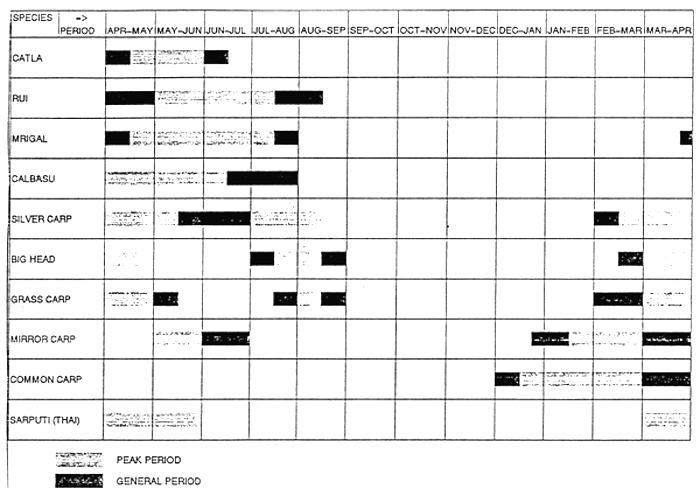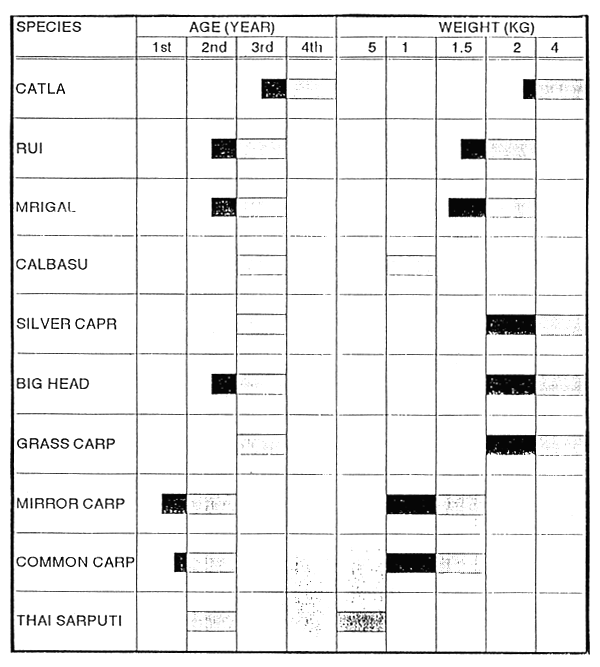PREPARATION OF BROODFISH
I. Preparation of Broodfish for First Reproduction
Pond preparation
Removal of weed fish by dewatering/drying of pond or by poisoning (Rotenon at the rate of img/liter or Phostoxin at the rate of 0.25–0.30 mg/liter).
Liming after dewatering or 1–3 days after poisoning at the rate of 40–70 kg CaO/bigha.
Manuring at the rate of about 200 kg cowdung or 100–120 kg poultry drop, 6 kg urea and 3 kg TSP/bigha.
Bottom raking with “horra” daily before stocking.
Stocking
| Time | : | September-October |
| Stocking density | : | It should not be more than 250–370 kg/bigha. |
Suggested stocking ratios are given in Table 7.
TABLE 7
STOCKING RATIOS SUITABLE FOR BROODFISH PONDS
| SPECIES | COMBINATION TYPES (%) | ||||||
| 1. | 2. | 3. | 4. | 5. | 6. | 7. | |
| Catla | - | 35 | 30 | 100* | 60 | - | - |
| S. carp | 35 | - | - | - | - | 70 | 20 |
| G. carp | 5 | 10 | 5 | - | - | - | 60 |
| Rohu | 30 | 30 | 25 | - | 20 | 10 | 10 |
| Mrigal | 30 | - | 25 | - | 20 | 20 | 10 |
| M./C. carp | - | 25 | 15 | - | - | - | - |
| Total | 100 | 100 | 100 | 100 | 100 | 100 | 100 |
Feeding
Application of dough type feed is suggested at the rate of 2–3 percent of body weight. Some feed types are shown in Table 8.
TABLE 8
COMPOSITION OF DIFFERENT TYPES OF BROODFISH FEEDS
| INGREDIENTS (%) | FEED TYPES | |||
| I. | II. | III. | IV. | |
| Wheat bran | 30 | 40 | 40 | |
| Rice polish | 10 | 50 | ||
| Mustard oil cake | 20 | 20 | 32 | 20 |
| Fish meal | 25 | 20 | 5 | 10 |
| Cattle blood | 10 | 20 | ||
| Ground duckweed | 10 | 20 | ||
| Molasses | 4.8 | 2 | ||
| Vitamin premix | 0.2 | |||
| Wheat flouer | 10 | |||
| Soyabean oil | 1 | |||
Daily application of duckweed, napier grass, banana leaf or fresh green grass is essential for grass carp preparation at the rate of 10–40 percent of body weight of grass carp broodstock.
Pond treatment during rearing
Daily manuring at the rate of about 7–12 kg cowdung and 0.1–0.4 artificial fertilizers per bigha.
Raking of pond bottom 1–2 times a week.
From February, at least fortnightly 1/4–1/5 of water should be removed and replenished.
Monthly liming of pond at the rate of 13–15 kg CaO/bigha.
II. Preparation of broodfish for second breeding
Pond preparation: as above.
Stocking
Spent broodfish should be stocked at the rate of 200–250kg/bigha.
Feeding
Daily ration is 3–5 % of body weight. Application of feed type I. is suggested. Fresh green grass or duckweed should be applied for grass carp, at the rate of 50–70 % of body weight.
Pond treatment
Daily manuring at the rate of 10–12 cowdung per bigha. Some artificial fertilizers are recommended when algal blooming is not satisfactory.
Daily application of horra.
Weekly flushing of ponds upto monsoon.
III. Additional data for planning of broodfish management
Calculation of broodfish requirement
TABLE 9
DATA FOR CALCULATION OF BROODFISH REQUIREMENT
| Species | Egg production of one female (pc) | Number of seed in traditional technology | No. of fingerlings in improved metdology | ||
| Feeding fry | Dhani | Fingerling | |||
| Catla | 125000 | 75000 | 26250 | 20000 | 33750 |
| Rohu | 400000 | 240000 | 84000 | 64000 | 108000 |
| Mrigal | 300000 | 180000 | 63000 | 48000 | 81000 |
| Calbasu | 350000 | 210000 | 73500 | 56000 | 94500 |
| Silver carp | 100000 | 60000 | 21000 | 16000 | 27000 |
| Grass carp | 80000 | 48000 | 16800 | 12800 | 21600 |
| Bighead carp | 80000 | 48000 | 16800 | 12800 | 21600 |
| Mirror carp | 150000 | 90000 | 31500 | 24000 | 40500 |
| Thai sarputi | |||||
* All the data are higher 20% if improved the method of broodfish management is applied.
Table 10 Breeding period of common culturable species in Bangladesh

Table 11 Age and weight of broodfish at first breeding

| Very good |  |
| Possible |  |
IV. Economy of broodfish management
For production of 1 kg spawn about 12–15 kg female and male broodfish are necessary, considering 1 spawning in one season. Broodfish requirement for production of 50 kg spawn is 700 kg broodfish. To maintain this broodfish population, about 0.4 ha pond is required.
The expenditures incurred for maintenance of broodfish in a 0.4 ha pond are:
| Items | Taka |
| Value of broodfish | 21 000 |
| Amortization (10%) | 2 100 |
| Preparation of broodfish pond | |
| Dewatering/refiiling | 5 500 |
| 150 kg lime | 750 |
| 800 kg cowdung | 200 |
| 40 kg inorganic fertiliser | 250 |
| Daily maintanence | |
| 30 kg cowdung | 12 |
| 1 kg fertilizer | 6 |
| 15 kg feed | 150 |
| Monthly labour cost | 500 |
| Monthly maintenance | @ 5 500 |
| Early pond rental cost | 4 000 |
| Bank interest (12%) | @ 9 500 |
| Sum of expenditures | @ 88 000 |
| Hazards (25 %) | @ 22 000 |
| TOTAL EXPENDITURES | @ 110 000 |
